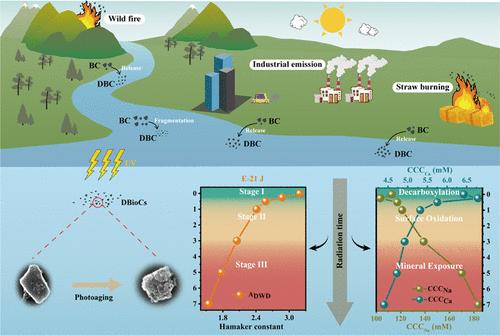当前位置:
X-MOL 学术
›
Environ. Sci. Technol.
›
论文详情
Our official English website, www.x-mol.net, welcomes your feedback! (Note: you will need to create a separate account there.)
New Insights into Aggregation Behaviors of the UV-Irradiated Dissolved Biochars (DBioCs) in Aqueous Environments: Effects of Water Chemistries and Variation in the Hamaker Constant
Environmental Science & Technology ( IF 11.4 ) Pub Date : 2024-04-25 , DOI: 10.1021/acs.est.4c00780 Ning Tang 1, 2 , Yihui Guo 1, 2 , Ziqian Zhu 1, 2 , Longbo Jiang 1, 2 , Na Li 1, 2 , Tingting Hu 1, 2 , Lan Lu 1, 2 , Jingyi Zhang 1, 2 , Xiaodong Li 1, 2 , Jie Liang 1, 2
Environmental Science & Technology ( IF 11.4 ) Pub Date : 2024-04-25 , DOI: 10.1021/acs.est.4c00780 Ning Tang 1, 2 , Yihui Guo 1, 2 , Ziqian Zhu 1, 2 , Longbo Jiang 1, 2 , Na Li 1, 2 , Tingting Hu 1, 2 , Lan Lu 1, 2 , Jingyi Zhang 1, 2 , Xiaodong Li 1, 2 , Jie Liang 1, 2
Affiliation

|
The aggregation behavior of ubiquitous dissolved black carbon (DBC) largely affects the fate and transport of its own contaminants and the attached contaminants. However, the photoaging processes and resulting effects on its colloidal stability remain yet unknown. Herein, dissolved biochars (DBioCs) were extracted from common wheat straw biochar as a proxy for an anthropogenic DBC. The influences of UV radiation on their aggregation kinetics were systematically investigated under various water chemistries (pH, electrolytes, and protein). The environmental stability of the DBioCs before and after radiation was further verified in two natural water samples. Hamaker constants of pristine and photoaged DBioCs were derived according to Derjaguin–Landau–Verwey–Overbeek (DLVO) prediction, and its attenuation (3.19 ± 0.15 × 10–21 J to 1.55 ± 0.07 × 10–21 J after 7 days of radiation) was described with decay kinetic models. Pearson correlation analysis revealed that the surface properties and aggregation behaviors of DBioCs were significantly correlated with radiation time (p < 0.05), indicating its profound effects. Based on characterization and experimental results, we proposed a three-stage mechanism (contended by photodecarboxylation, photo-oxidation, and mineral exposure) that DBioCs might experience under UV radiation. These findings would provide an important reference for potential phototransformation processes and relevant behavioral changes that DBC may encounter.
中文翻译:

对水环境中紫外线照射溶解生物炭 (DBioC) 聚集行为的新见解:水化学的影响和 Hamaker 常数的变化
普遍存在的溶解黑碳(DBC)的聚集行为在很大程度上影响其自身污染物和附着污染物的命运和运输。然而,光老化过程及其对其胶体稳定性的影响仍然未知。在此,从普通麦秆生物炭中提取溶解生物炭(DBioC)作为人为 DBC 的替代品。在各种水化学(pH、电解质和蛋白质)下系统地研究了紫外线辐射对其聚集动力学的影响。在两个天然水样中进一步验证了辐射前后 DBioCs 的环境稳定性。原始和光老化 DBioC 的 Hamaker 常数根据 Derjaguin–Landau–Verwey–Overbeek (DLVO) 预测得出,及其衰减(辐射 7 天后从3.19 ± 0.15 × 10 –21 J 到 1.55 ± 0.07 × 10 –21 J)用衰变动力学模型来描述。 Pearson相关分析显示,DBioCs的表面性质和聚集行为与辐射时间显着相关(p <0.05),表明其影响深远。根据表征和实验结果,我们提出了 DBioCs 在紫外线辐射下可能经历的三阶段机制(包括光脱羧、光氧化和矿物质暴露)。这些发现将为DBC可能遇到的潜在光转化过程和相关行为变化提供重要参考。
更新日期:2024-04-25
中文翻译:

对水环境中紫外线照射溶解生物炭 (DBioC) 聚集行为的新见解:水化学的影响和 Hamaker 常数的变化
普遍存在的溶解黑碳(DBC)的聚集行为在很大程度上影响其自身污染物和附着污染物的命运和运输。然而,光老化过程及其对其胶体稳定性的影响仍然未知。在此,从普通麦秆生物炭中提取溶解生物炭(DBioC)作为人为 DBC 的替代品。在各种水化学(pH、电解质和蛋白质)下系统地研究了紫外线辐射对其聚集动力学的影响。在两个天然水样中进一步验证了辐射前后 DBioCs 的环境稳定性。原始和光老化 DBioC 的 Hamaker 常数根据 Derjaguin–Landau–Verwey–Overbeek (DLVO) 预测得出,及其衰减(辐射 7 天后从3.19 ± 0.15 × 10 –21 J 到 1.55 ± 0.07 × 10 –21 J)用衰变动力学模型来描述。 Pearson相关分析显示,DBioCs的表面性质和聚集行为与辐射时间显着相关(p <0.05),表明其影响深远。根据表征和实验结果,我们提出了 DBioCs 在紫外线辐射下可能经历的三阶段机制(包括光脱羧、光氧化和矿物质暴露)。这些发现将为DBC可能遇到的潜在光转化过程和相关行为变化提供重要参考。



























 京公网安备 11010802027423号
京公网安备 11010802027423号